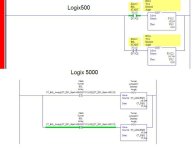I use a lot of indirect addressing in my programs.
In a Rockwell Logix500 (Micro, SLC500, etc..) system, indirect addressing of bits is pretty straight forward, but I've yet to find similar way on the Logix5000 (Compact, Control, etc...) platform to indirectly address BITS.
Logix5000 follows WORD indirect addressing in a similar manner as Logix500, but with BITS it requires the LOOOONG string shown in the attached pic.
I got the Logix5000 technique from the KB, but maybe one of you gee-wizards can show me how to clean this up (or not)
Maybe its just what I have to live with for....progress...?
Thanks!

In a Rockwell Logix500 (Micro, SLC500, etc..) system, indirect addressing of bits is pretty straight forward, but I've yet to find similar way on the Logix5000 (Compact, Control, etc...) platform to indirectly address BITS.
Logix5000 follows WORD indirect addressing in a similar manner as Logix500, but with BITS it requires the LOOOONG string shown in the attached pic.
I got the Logix5000 technique from the KB, but maybe one of you gee-wizards can show me how to clean this up (or not)
Maybe its just what I have to live with for....progress...?
Thanks!



